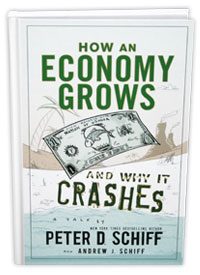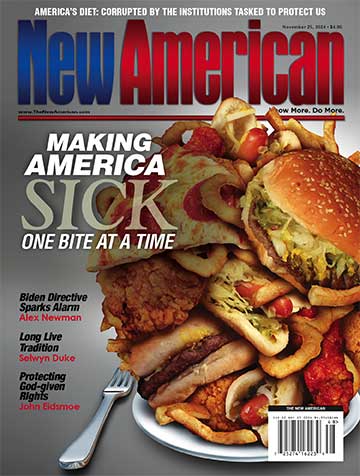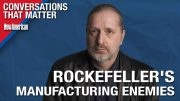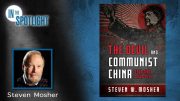
If this writer were to claim that Peter and Andrew Schiff have created the master work of introducing basic Austrian economics that could be clearly understood by anyone of middle-school age and older, I would be only partly incorrect in describing their new book, How an Economy Grows and Why It Crashes.
The genius of this book comes from neither Peter nor Andrew Schiff, however. Much of the credit belongs to Irwin A. Schiff, who created the first draft of this introduction to Austrian economics back in 1985. The Schiff brothers acknowledge that “this story would best be described as a riff on the original.” But Peter and Andrew Schiff have perfected their father’s already brilliant work, which had some presentational shortcomings. The sons have new illustrations by Brendan Leach, and additional material that brings the text up to date.
In other words the Schiff brothers have, as good capitalists have done for generations, improved the works of their forebears and risen to new heights. Lew Rockwell of the Ludwig von Mises Institute is in the habit of saying that the best introduction to Austrian economics is Tom Woods’ brilliant Meltdown. Although he has been correct on that point, he may no longer be.
This short, easy read is a work of genius, illustrating economic concepts using a simple island economy of three people — Able, Baker, and Charlie — dependent upon their livelihood by fishing with their hands. The authors explain how the three improve their lives by creating “capital” (fishing nets and other technology) through risk-taking investment, under-consumption, and savings. The economic basics are outlined in the first 90 pages of this book, including money (“fish” on the island economy), inflation, and banking. The subject matter is covered almost in comic-book style.
The second part of the book attacks Keynesian “controlled economy” economic fallacies that politicians have pushed since the New Deal, employing fishy/nautical names for historical figures who took part in development or government destruction of the island economy such as Franky Deep (Franklin Delano Roosevelt), Buddy Goldfin (Barry Goldwater), and Ally Greenfin (Alan Greenspan). Peter Schiff even makes a cameo in the mythical island fish world as “Piker Skiff,” an accurate economist who’s laughed at on talk shows by conventional political operators. This matches the real world, as Peter Schiff was indeed laughed at on numerous talk shows in 2006 and 2007 for accurately predicting the current “Great Recession” and explaining in detail why and how it would happen.
The genius of this book is that even a middle-school economics student could understand the basic concepts outlined in this book. As a teacher of high-school students, I can testify that this book could be understood by even the most basic of my students. It would make an excellent textbook for an “Introduction to Economics” course in any high school or middle school.
While children should be able to understand the concepts outlined in this book, adults desperately need to understand these concepts as well. But most don’t. This book could be an easy cure for economic ignorance, as most adults could absorb it in a few hours. The Schiff brothers take on the greatest economic myth of the modern era: Deflation is bad, but inflation is good. They note in digressions from the book’s narrative that “during a recession prices need to fall in order to rebalance the economy. Recessions should be deflationary. Falling prices will cushion the blow of low employment. Somehow, modern economists see falling prices as a never-ending abyss toward demand destruction. They forget that when prices fall far enough, people start spending again. The process allows unneeded inventories to be worked off, and for prices to fall to a level justified by underlying supply and demand. By keeping prices artificially high, inflation prevents this from happening.”
The Schiffs explain that despite the political emphasis on job creation, “it is not the aim of an economy to provide jobs. The goal is simply to increase productivity.” Even raw economic growth numbers can sometimes be deceiving, if the growth is based upon government stimulus. Government stimulus leads to inefficient investment, which creates bubbles that must eventually burst.
Such was the case with the housing bubble, which all economists — except those from the Austrian school — failed to predict. The Schiff brothers note: “It was as if all the meteorologists in the country failed to predict a category 5 hurricane when it was just 10 miles off the coast of Miami. Is there any more evidence needed to confirm the utter cluelessness of mainstream economic thinkers?” Yet despite the urgent pleas of warning from Peter Schiff and hundreds of other Austrian economists, the refrain from most people after the bust was that nobody could have known.
But the signs were clear for anyone who took the time to look that a bubble had formed. Citing Robert Schiller’s Irrational Exuberance, Schiff notes that “in the 100 years between 1900 and 2000, home prices increased by 3.4 percent per year (which is slightly higher than the rate of inflation). There were good reasons for this. Prices were firmly tied to people’s ability to pay, which is a function of income and credit availability. But from 1997 to 2006 national home prices gained an astounding 19.4 percent per year on average. So why would people pay so much? The difference was credit, which government policy made much cheaper and easier to get.”
Sadly, even most college-educated people today can’t put their finger on the real cause of the housing bubble/bust, other than to label it as “greed.” Greed was the main cause. But most don’t know that it was greed for office, rather than just the banks’ financial greed. The Schiffs acknowledge this unfortunate fact: “Wall Street leaders were also irresponsible. The profits made by the big banks during the boom years were obscene. After the crash they should have paid far more dearly than they have. But bankers were playing the distorted hand dealt them by government.”
The Schiff brothers conclude: “So the good news is that now we have finally learned to be more realistic…. Right? Wrong. Even after the collapse of the mortgage market, people still don’t understand how home prices are influenced by government policies. And so while the Bush and Obama administrations have committed massive amounts of government resources to prop up the deflating market, people still don’t recognize how these trusses are simply extending the pain and setting us up for an even bigger fall.”
That’s not a happy picture, but they end the book on a hopeful note: “There is time to stop the train before it heads off the cliff.” They write: “We need leaders who have the courage to be honest with voters, and voters who have the strength to accept the hard work of economic renewal.” Part of that means rejecting the Keynesian consumer-spending pseudo-economy and acknowledging that “an economy can’t grow because people spend; people spend because an economy grows.”
The Schiff brothers have perfected one heck of a fish story. If enough Americans read this book, Keynes’ bogus economic voodoo will be thrown out to sea and America will see prosperity again.
How an Economy Grows and Why It Crashes, by Peter D. Schiff and Andrew J. Schiff, Hoboken, New Jersey: John Wiley and Sons, 2010, 233 pages, hardcover.



